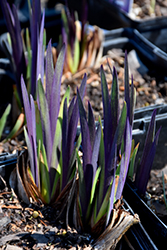>> Home
Plant Height: 24 inches
Flower Height: 3 feet
Spacing: 18 inches
Sunlight:
![]()
![]()
Hardiness Zone: 6b
Other Names: Robusta Iris
Group/Class: Hybrid Iris
Description:
This bog variety does well in wet environments, but also thrives elsewhere with adequate watering; attractive violet-blue blooms with yellow center streaks surrounded by white; great for a pondside garden
Ornamental Features
Gerald Darby Iris features showy violet flag-like flowers with blue overtones and a yellow blotch at the ends of the stems from late spring to early summer. The flowers are excellent for cutting. Its sword-like leaves emerge purple in spring, turning grayish green in colour throughout the season.
Landscape Attributes
Gerald Darby Iris is an herbaceous perennial with an upright spreading habit of growth. Its relatively fine texture sets it apart from other garden plants with less refined foliage.
This plant will require occasional maintenance and upkeep, and should be cut back in late fall in preparation for winter. Deer don't particularly care for this plant and will usually leave it alone in favor of tastier treats. Gardeners should be aware of the following characteristic(s) that may warrant special consideration;
- Insects
Gerald Darby Iris is recommended for the following landscape applications;
- Mass Planting
- Border Edging
- General Garden Use
- Bog Gardens
Planting & Growing
Gerald Darby Iris will grow to be about 24 inches tall at maturity extending to 3 feet tall with the flowers, with a spread of 24 inches. When grown in masses or used as a bedding plant, individual plants should be spaced approximately 18 inches apart. It grows at a medium rate, and under ideal conditions can be expected to live for approximately 10 years. As an herbaceous perennial, this plant will usually die back to the crown each winter, and will regrow from the base each spring. Be careful not to disturb the crown in late winter when it may not be readily seen!
This plant does best in full sun to partial shade. It prefers to grow in moist to wet soil, and will even tolerate some standing water. It is not particular as to soil type or pH. It is somewhat tolerant of urban pollution. This particular variety is an interspecific hybrid. It can be propagated by division; however, as a cultivated variety, be aware that it may be subject to certain restrictions or prohibitions on propagation.
This plant is not reliably hardy in our region, and certain restrictions may apply; contact the store for more information.

